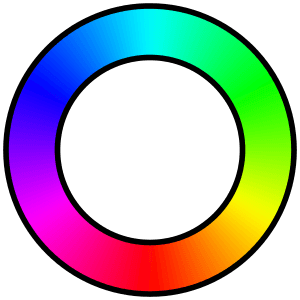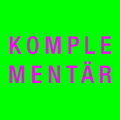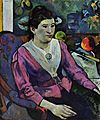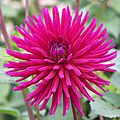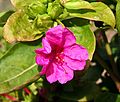Magenta facts for kids
| This box shows the color magenta. |
|---|

Magenta is a bright, vibrant color that sits between red and purple. Some people might confuse it with pink or purple, but it's its own special shade! Think of it as a mix of red and blue light, equally balanced. Another common name for magenta is fuchsia, which comes from the beautiful fuchsia flower.
This exciting color is super important in the world of printing. If you have an inkjet printer, you'll find magenta ink inside, along with cyan (a type of blue) and yellow. When these three colors mix, they can create almost any other color you see on a printed page! The specific shade of magenta used in printing is often called "printer's magenta."
The word "magenta" was first used to describe this color in the English language in 1860.
Contents
What Makes Magenta Special?
Magenta is a unique color because it's not found in the rainbow (the visible spectrum of light). Instead, our brains create magenta when they see a mix of red and blue light.
- In Light: When you mix equal amounts of red and blue light, you get magenta. This is how screens like your computer or TV make the color.
- In Print: In printing, magenta is one of the "primary" colors of ink. This means it's a basic color that can be mixed with others to make a huge range of different shades.
Magenta in the Color Wheel
Imagine all the colors of the rainbow bent into a circle, like a color wheel. If you connect the ends of the rainbow (red and violet), you'll find magenta right in the middle! This shows how it's a bridge between red and violet.
Magenta in Art and History
Magenta became very popular in the second half of the 1800s. This was thanks to new aniline dyes, which were artificial colors that made bright, bold shades possible. Artists and fashion designers loved using magenta to make things stand out!
- In the 1960s, magenta was a favorite color in psychedelic art. This art style used bright, swirling colors to create exciting and sometimes dream-like effects.
Related pages
Images for kids
-
In the RGB color model, used for computer and TV screens, magenta is made by mixing equal amounts of blue and red light.
-
Magenta is the complementary color of green. This means they are opposite each other on the color wheel. When you put them side-by-side, they look extra bright!
-
Magenta became a popular fashion color in the late 1800s. It also appeared in art, like this 1890 painting, Psyche, by Bouguereau.
-
Paul Gauguin, Portrait of Marie Lagadu (1890). Artists like Gauguin used bold colors.
-
Henri Matisse, Les toits de Collioure (1905). Henri Matisse and the Fauvist painters were among the first to use magenta in a big way to create strong feelings in viewers.
-
Coral from the Persian Gulf often comes in beautiful magenta shades.
-
An Andean flamingo (Phoenicopterus andinus) showing its natural magenta feathers.
-
A dragonfly, or Anisoptera Ana Cotta, with hints of magenta.
-
Pseudanthias tuka, a colorful reef fish from the Indian Ocean.
-
An Orchid Phalaenopsis, known for its vibrant colors.
-
A beautiful Rhododendron flower.
-
Clematis "Sunset" flower.
-
A Dahlia "Hillcrest Royal" flower.
-
Rambler roses can have lovely magenta tones.
-
Syringa "Paul Deschanel" flowers.
-
Lily "Malinoviy Zvon" flower.
-
Polemoniaceae, or phlox flower.
-
A vibrant cactus flower.
-
Achillea "Staroe Burgundskoe" flower.
-
Mirabilis jalapa "Four O'Clock Flower".
See also
 In Spanish: Magenta para niños
In Spanish: Magenta para niños


